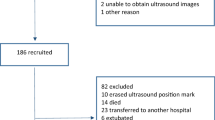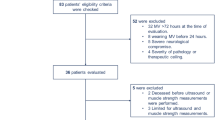Abstract
Purpose
Skeletal muscle ultrasound is a valuable tool for assessing muscle wasting in ICU. Previous studies on skeletal muscle ultrasound in ICU have been performed on lower limb muscles. The current study is formulated to assess the feasibility and reliability of anterior temporalis (AT) muscle ultrasound for measuring muscle wasting in ICU.
Methods
In this prospective cohort study in 48 critically ill patients with sepsis, muscle layer thicknesses (MLTs) and mean grayscale (GS) values of anterior temporalis muscles and quadriceps femoris (Q) were measured at baseline and serially till 7 days. Correlation was made between baseline and change in MLT and GS values of AT and Q muscle and these parameters were compared between ICU survivors and non survivors.
Results
Baseline anterior temporalis MLTs or their longitudinal changes over 7 days did not correlate significantly with the corresponding parameters of quadriceps femoris muscles. The baseline GS values of two muscle groups correlated weakly at baseline, but the change in GS over 7 days showed no correlation. The baseline MLTs of both muscle groups and their longitudinal change over 7 days did not correlate with ICU length of stay. The change in MLT of AT over 7 days was significantly greater in ICU non-survivors compared to survivors.
Conclusion
Measurement of ultrasonographic muscle layer thickness and grayscale parameters of anterior temporalis muscle did not show good correlation with that of quadriceps muscle.



Similar content being viewed by others
References
Reeves ND, Maganaris CN, Narici MV (2004) Ultrasonographic assessment of human skeletal muscle size. Eur J Appl Physiol 91(1):116–118
Paris MT, Mourtzakis M, Day A, Leung R, Watharkar S, Kozar R et al (2017) Validation of bedside ultrasound of muscle layer thickness of the quadriceps in the critically Ill patient (VALIDUM study). JPEN J Parenter Enteral Nutr 41(2):171–180
Chi-Fishman G, Hicks JE, Cintas HM, Sonies BC, Gerber LH (2004) Ultrasound imaging distinguishes between normal and weak muscle. Arch Phys Med Rehabil 85(6):980–986
Freilich RJ, Kirsner RL, Byrne E (1995) Isometric strength and thickness relationships in human quadriceps muscle. Neuromuscul Disord NMD 5(5):415–422
Gruther W, Benesch T, Zorn C, Paternostro-Sluga T, Quittan M, Fialka-Moser V et al (2008) Muscle wasting in intensive care patients: ultrasound observation of the M. quadriceps femoris muscle layer. J Rehabil Med 40(3):185–189
Puthucheary ZA, Rawal J, McPhail M, Connolly B, Ratnayake G, Chan P et al (2013) Acute skeletal muscle wasting in critical illness. JAMA 310(15):1591–1600
Parry SM, El-Ansary D, Cartwright MS, Sarwal A, Berney S, Koopman R et al (2015) Ultrasonography in the intensive care setting can be used to detect changes in the quality and quantity of muscle and is related to muscle strength and function. J Crit Care 30(5):1151.e9–14
Grimm A, Teschner U, Porzelius C, Ludewig K, Zielske J, Witte OW et al (2013) Muscle ultrasound for early assessment of critical illness neuromyopathy in severe sepsis. Crit Care Lond Engl 17(5):R227
Formenti P, Umbrello M, Coppola S, Froio S, Chiumello D (2019) Clinical review: peripheral muscular ultrasound in the ICU. Ann Intensive Care 9(1):57
Singer M, Deutschman CS, Seymour CW, Shankar-Hari M, Annane D, Bauer M et al (2016) The third international consensus definitions for sepsis and septic shock (Sepsis-3). JAMA 315(8):801–810
Tillquist M, Kutsogiannis DJ, Wischmeyer PE, Kummerlen C, Leung R, Stollery D et al (2014) Bedside ultrasound is a practical and reliable measurement tool for assessing quadriceps muscle layer thickness. JPEN J Parenter Enteral Nutr 38(7):886–890
Kant P, Bhowate RR, Sharda N (2014) Assessment of cross-sectional thickness and activity of masseter, anterior temporalis and orbicularis oris muscles in oral submucous fibrosis patients and healthy controls: an ultrasonography and electromyography study. Dento Maxillo Facial Radiol 43(3):20130016
Sharshar T, Bastuji-Garin S, Stevens RD, Durand M-C, Malissin I, Rodriguez P et al (2009) Presence and severity of intensive care unit-acquired paresis at time of awakening are associated with increased intensive care unit and hospital mortality. Crit Care Med 37(12):3047–3053
Ali NA, O’Brien JM, Hoffmann SP, Phillips G, Garland A, Finley JCW et al (2008) Acquired weakness, handgrip strength, and mortality in critically ill patients. Am J Respir Crit Care Med 178(3):261–268
De Jonghe B, Bastuji-Garin S, Durand M-C, Malissin I, Rodrigues P, Cerf C et al (2007) Respiratory weakness is associated with limb weakness and delayed weaning in critical illness. Crit Care Med 35(9):2007–2015
De Jonghe B, Bastuji-Garin S, Sharshar T, Outin H, Brochard L (2004) Does ICU-acquired paresis lengthen weaning from mechanical ventilation? Intensive Care Med 30(6):1117–1121
Hermans G, Van Mechelen H, Clerckx B, Vanhullebusch T, Mesotten D, Wilmer A et al (2014) Acute outcomes and 1-year mortality of intensive care unit-acquired weakness. A cohort study and propensity-matched analysis. Am J Respir Crit Care Med 190(4):410–420
Abe T, Loenneke JP, Thiebaud RS (2015) Morphological and functional relationships with ultrasound measured muscle thickness of the lower extremity: a brief review. Ultrasound Leeds Engl 23(3):166–173
Borges RC, Soriano FG (2019) Association between muscle wasting and muscle strength in patients who developed severe sepsis and septic shock. Shock Augusta Ga 51(3):312–320
Furtner J, Berghoff AS, Schöpf V, Reumann R, Pascher B, Woitek R et al (2018) Temporal muscle thickness is an independent prognostic marker in melanoma patients with newly diagnosed brain metastases. J Neurooncol 140(1):173–178
Cartwright MS, Kwayisi G, Griffin LP, Sarwal A, Walker FO, Harris JM et al (2013) Quantitative neuromuscular ultrasound in the intensive care unit. Muscle Nerve 47(2):255–259
Puthucheary ZA, Phadke R, Rawal J, McPhail MJW, Sidhu PS, Rowlerson A et al (2015) Qualitative ultrasound in acute critical illness muscle wasting. Crit Care Med 43(8):1603–1611
Sarwal A, Parry SM, Berry MJ, Hsu F-C, Lewis MT, Justus NW et al (2015) Interobserver reliability of quantitative muscle sonographic analysis in the critically Ill population. J Ultrasound Med Off J Am Inst Ultrasound Med 34(7):1191–1200
Author information
Authors and Affiliations
Contributions
All authors contributed to the study conception and design. Material preparation was performed by Anirban Bhattacharjee (AB), Rahul Kumar Anand (RKA), Rajeshwari Subramaniam (RS), Dalim Kumar Baidya (DKB), Vimi Rewari (VR), and Manisha Jana (MJ). Data collection was done by AB, RA and MJ. Data analysis was done by AB, DKB, Bikash Ranjan Ray (BKR) and Puneet Khanna (PK). The first draft of the manuscript was written by AB, RA and DKB and all authors commented on previous versions of the manuscript. All authors read and approved the final manuscript.
Corresponding author
Ethics declarations
Conflict of interest
Authors have no conflict of interest to declare in relation to the present study.
Funding
No funding received.
Ethical clearance
Ethical clearance was obtained from the institute ethics board, and the trial was pre-registered with the national clinical trial registry.
Trial registration number: CTRI/2018/09/015827 [Registered on: 25/09/2018].
Informed consent
Informed consent was obtained from all patients or their legal guardians.
Consent to publish
The authors affirm that participants provided consent for publication of the images in Figures 1 and 2.
Additional information
Publisher's Note
Springer Nature remains neutral with regard to jurisdictional claims in published maps and institutional affiliations.
Rights and permissions
About this article
Cite this article
Anand, R.K., Bhattacharjee, A., Baidya, D.K. et al. Feasibility of anterior temporalis muscle ultrasound for assessing muscle wasting in ICU: a prospective cohort study. J Ultrasound 26, 653–661 (2023). https://doi.org/10.1007/s40477-022-00703-1
Received:
Accepted:
Published:
Issue Date:
DOI: https://doi.org/10.1007/s40477-022-00703-1




